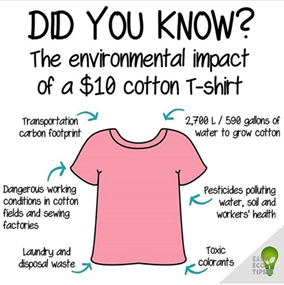Applied Jainism – is a social platform to collaborate & discuss contemporary issues on sustainable co-existence (Parasparopagraho Jīvānām / परस्परोपग्रहो जीवानाम् where the principle of Jain philosophy & spirituality can guide us and become the torch bearer in the modern age. www.appliedjainism.in
Jainavenue is a medium to serve the spiritual path of Jainism

Did you know that our frequent and impulsive urge for new clothing creates long-term and potentially irreversible environmental damage and impacts several living beings and micro-organism! Clothes and its supply chain is the third largest polluting industry, emitting 10% of global greenhouse gas emissions.
Clothes are hurting many lives in many ways, across their lifecycle, right from the production of the raw materials, cloth production, dyeing, transportation and last but not the least, disposing the used clothes. Let’s take a quick look!
Fabric Production:
- Cotton – 25% of the world’s Pesticides are used for Cotton Production. It takes 2,700 liters of water to make one cotton shirt!!!! This is the same amount of water that a person drinks over 2.5 years. A whopping 7,000 liters to make one pair of jeans which is equivalent to water one person drinks over 6 years!
- Polyester – Nearly 70% of our clothing (polyester or other synthetic fabrics) is made from non-renewables like crude oil and every year, over 70 million barrels of oil are used to make polyester fibers).
- Silk is a topic by itself. Nearly 6,600 silkworms are killed to make just to make one saree.
- Animal Origin Products -The shoes, the hand-bags, the jacket, the belt: Many a times people argue that these products are made from “leftover” and animals were killed for meat. Just because we are not buying the shoes from the butcher, doesn’t mean that it doesn’t involve himsa. The butcher kills animals because of the cumulative price he would get for meat, for skin, for bones and all the other body parts. If people stop buying all the other animal parts, the price of meat would increase, and as we know through economics higher price would lead to lower demand.
Dyeing:
More than 99% of the dyes used are all chemical based and thus dyeing process releases a cocktail of chemicals, salts and heavy metals that hurt the environment and pollute essential drinking water sources. Fashion is responsible for up to one-fifth of industrial water pollution, as wastewater is commonly dumped directly into rivers and streams, killing aquatic plants and animals. Chemical-laden water is also used to irrigate crops, resulting in textile dyes making their way into vegetables and fruit grown.
Washing:
Detergents are tough on stains but also on our planet. Detergents don’t completely biodegrade; they contaminate our rivers and oceans with toxic heavy metals, resulting in killing of marine life.
- Synthetic clothes, like nylon, polyester, and rayon, all essentially plastic derivatives, release billions of microplastics (teeny bits of plastic smaller than one millimetre) when washed. These microplastics eventually make their way into oceans where they slowly bioaccumulate up the food chain.
Delivery:
With world as one global market, we might be buying T-shirts made of cotton grown in our backyard after it has travelled through the world as spinning, weaving, dyeing, and stitching could all happen in different counties based on availability of cheap labour and technology. This huge transportation has precipitated with the rising ecommerce industry and associated increase in returned goods. Reverse logistics, re-packaging all entail cost, and many e-commerce retailers prefer to burn down their goods instead of transporting them back to their source, adding to himsa and the pollution burden.
Disposal Process:
- Post use, only 14% of clothes get recycled. Almost ONE garbage truck of clothes is burned or sent to the landfill every second. Wool, if in landfills releases methane during its decaying process. Add to this, all Luxury brands, in order to protect their brand identity, to create scarcity of their goods and to maintain the exclusivity of their brands, choose to burn their products instead of discounting them!
So, what is the solution here? As told by Lord Mahavira, Apiragrah is one approach! Go on a fashion diet! Buy limited clothes, decrease your frequency of buying.
Another interesting and upcoming trend abroad, is the emergence of Renting, Sharing clothes through Clothes Libraries.
Also, the emergence of Sustainable Shopping Marketplaces, in India and globally is a positive move. Last but the least, remember that just by using a dress 9 months longer, we can reduce the environmental costs up to a 30 per cent! Covid has made many of us more conscious of our choices and choosing what we wear is clearly one BIG step ahead in our quest for moving upwards in Ahimask lifestyle.
Unfortunate Fact!
The fashion industry uses around 93 billion cubic meters (21 trillion gallons) of water annually….
….enough to fill 37 million Olympic swimming pools
Source: Ellen MacArthur Foundation
About Author
Dimple is an MBA, Finance from NMIMS. Currently working as Asst. VP at a Leading privately held professional services, company, she has supported Eco-friendly initiatives at the Inner Wheel Club of Thane Garden City since, 2018. Looking for opportunities to make a meaningful impact about Climate, she joined the Applied Jainism team.


So true. It needs to be translated in other Indian languages so more jain & non jain read & do their possible to reduce the environment damage